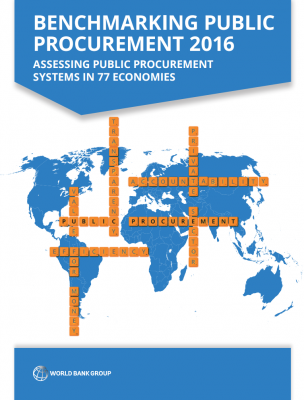
Did you know that public procurement — goods and services bought by governments — accounts for around one-fifth of global GDP? Or that in most high-income economies public procurement takes up a third of total public spending, and in developing countries even more – about half?
These figures represent a significant share of national wealth. If channeled properly, public procurement provides indispensable benefits to a society, such as infrastructure, hospitals, and schools. Yet, if squandered, public procurement can set back the economy and contribute to massive corruption. In fact, the Organisation for Economic Co-Operation and Development (OECD) estimates that corruption drains 20-25 percent of procurement budgets globally, which amounts to staggering $2 trillion per year.
The World Bank’s recent report, Benchmarking Public Procurement 2016, goes beyond the aggregate numbers to compare data on regulatory environments that affect the ability of companies to do business with the government in an open and transparent way.
The report is the second installment that expanded from just 10 economies in the pilot edition to 77 economies in East Asia and the Pacific (10 economies), Europe and Central Asia (10), Latin America and the Caribbean (13), Middle East and North Africa (7), South Asia (2), Sub-Saharan Africa (19), and the OECD countries (16). The benchmark focuses on the entire procurement life cycle: from preparing, submitting, and evaluating bids, to awarding and executing contracts. It also includes a comparison of complaint and reporting mechanisms.
The results show that, while some positive trends are visible, “transparency of public procurement regulations is far from optimal.” The following are the report highlights:
- There is a clear move toward the use of electronic means in conducting public procurement.
- Although several economies have modern and sound public procurement regulations, implementation of these regulations lags behind.
- Transaction costs are still high in a number of instances throughout the public procurement process.
These findings align with the results of a project that CIPE and Transparency International (TI) conducted a few years ago in four Asia Pacific Economic Cooperation (APEC) countries – Indonesia, Mexico, Peru, and Vietnam. CIPE and TI evaluated the implementation (in law and in practice) of the APEC Transparency Standards on Government Procurement by reviewing the relevant policies and regulations, and by conducting consultations with the private sector in each country.
Certainly, progress has been made on many fronts. However, we found that government commitments to transparency were not always fulfilled, and that even the best-intentioned technical improvements, such as e-procurement, can be circumvented for corrupt purposes.
The World Bank report brings much needed data on the subject, at both the global and country levels. Hopefully, by providing evidence and comparison between countries, it will motivate governments around the world to do more toward efficient and transparent public procurement.
Anna Kompanek is Director of Multiregional Programs at CIPE.

